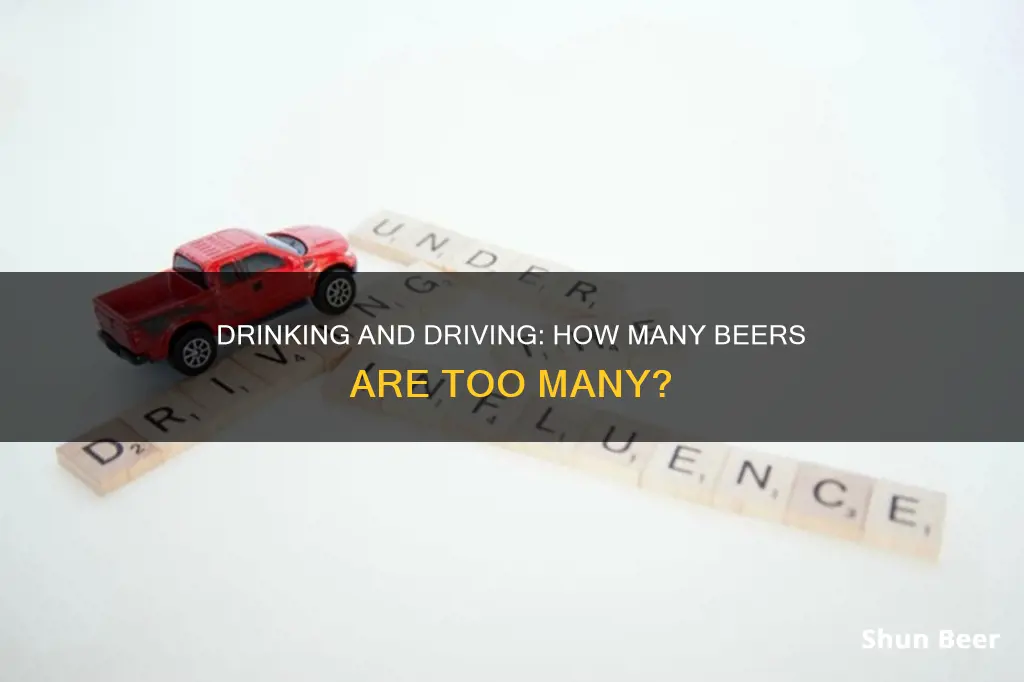
Drinking and driving is a serious issue that can lead to drunk driving charges, and even result in jail time. In the US, the legal blood alcohol limit is .08% across all states. This limit is considered a per se DUI, meaning that if your blood alcohol content is above this level, you are presumed to be too intoxicated to drive. However, it's important to note that you can still be charged with a drunk driving offense even if your blood alcohol level is below this threshold. The number of beers one can consume and still drive legally varies depending on several factors such as body weight, metabolic rate, gender, and the time elapsed since consuming alcohol. It's always best to avoid drinking and driving altogether and to arrange alternative transportation if you plan on drinking.
What You'll Learn

The one drink an hour rule
The "one drink an hour" rule is a commonly held belief that a person can consume one alcoholic drink per hour and remain under the legal blood alcohol content (BAC) limit for driving. This limit is typically set at 0.08% BAC in most places. The "one drink an hour" rule suggests that a person can have 1¼ ounces of hard liquor, one beer, or one glass of wine per hour and still be safe to drive.
However, it's important to understand that this rule may not be accurate for everyone. The key factor in determining BAC is the amount of alcohol consumed, but this can vary depending on individual factors such as body composition, weight, height, body fat, and metabolism. For example, a person with a higher metabolism may be able to process alcohol more quickly, while someone with a higher body fat percentage may take longer to metabolize alcohol. Additionally, not all alcoholic drinks are equal; a beer may affect someone differently than a strong liquor like vodka.
To illustrate the impact of individual factors, let's consider some examples. A 180-lb man may be able to consume 3.5 regular 12-ounce beers in an hour and maintain a BAC under the legal limit. On the other hand, a 140-lb woman may only be able to consume 2.5 regular beers in an hour and stay under the same limit. These estimates assume an average beer with a 5% alcohol by volume (ABV) level, but craft beers, IPAs, stouts, and ales often have higher ABV levels, which would affect BAC more significantly.
While the "one drink an hour" rule can provide a general guideline, it's crucial to recognize that it doesn't apply uniformly to everyone. Individual factors and the specific alcoholic drinks consumed can significantly influence BAC levels. As such, it's always best to exercise caution and refrain from driving after consuming alcohol. If you plan on drinking, it's advisable to arrange alternative transportation methods, such as designating a sober driver or using public transportation.
Beer and Surgery: What's the Safe Wait Time?
You may want to see also

Gender differences
When it comes to drinking beer and driving legally, it's important to understand the impact of gender differences on blood alcohol concentration (BAC) levels. While legal limits for BAC vary across regions, it's essential to recognize that gender is a contributing factor to BAC levels, along with other factors such as body weight, food intake, rate of consumption, and individual health conditions.
In the United States, the legal BAC limit for driving is .08%. However, the number of beers one can consume and still drive legally differs between men and women due to variations in body composition and alcohol metabolism. Generally, women tend to have a higher BAC than men when consuming the same amount of alcohol because they typically have lower body weight and higher body fat and water content.
For example, a 100-pound woman consuming three drinks would have a BAC of 0.14%, while an 180-pound man consuming the same amount would have a BAC of 0.06%. This difference is crucial to consider when determining how many beers a person can legally consume before driving. Additionally, factors like metabolic rate, the alcohol content of the beer, and the consumption of food can also influence BAC levels.
It's worth noting that the impact of gender differences on BAC levels may vary across different racial groups. Previous charts suggested specific BAC levels based on weight and gender. However, these charts were found to be accurate primarily for Caucasian individuals due to variations in the enzyme that metabolizes alcohol in the liver across different racial groups.
While legal limits and guidelines exist, the safest option is to refrain from driving after consuming any amount of alcohol. Alcohol impairs judgment, slows reaction time, and reduces the ability to make quick decisions, all of which can lead to dangerous situations on the road. Therefore, it is recommended to utilize alternative transportation options, such as ridesharing services, public transportation, or designated drivers, to ensure safety.
Plasma Donation and Beer: A Day's Difference
You may want to see also

Weight differences
Weight plays a significant role in determining how many beers a person can drink and still drive legally. While the legal blood alcohol concentration (BAC) limit for driving in most places is 0.08%, the number of drinks it takes to reach this limit varies depending on weight.
For example, a person weighing 100 pounds can typically only have one serving of alcohol before reaching a BAC of 0.08 and only two servings before exceeding 0.1. On the other hand, a person weighing 180 pounds can usually consume around three regular 12-ounce beers in an hour and stay under the 0.08% limit. A person weighing 220 pounds or more can generally have four or more drinks and still be under the legal limit.
It's important to note that these are just estimates, and the actual BAC can vary based on several factors, including gender, metabolic rate, alcohol tolerance, muscle mass, height, and whether the person has consumed food or medication. Additionally, the alcohol content of different beers can vary, with craft beers typically having a higher alcohol percentage than light beers.
To ensure safety, it's always best to refrain from driving after consuming alcohol. The effects of alcohol can impair judgment and reflexes, putting yourself and others at risk. If you plan to drink, consider alternative transportation options such as public transit, ride-sharing services, or a designated driver. Remember, the legal consequences and risks associated with drunk driving far outweigh the convenience of getting behind the wheel.
Mixing Beer and Adderall: What You Need to Know
You may want to see also

Alcohol by volume (ABV)
The amount of beer a person can drink and still drive legally depends on many factors, including their weight, gender, metabolic rate, time of day, and whether they have consumed food. Beer alcohol content is measured by percentage of alcohol by volume, or ABV. In the US, a standard drink is defined as containing around 14 grams (0.6 ounces) of pure alcohol. This is generally found in 12 ounces of beer, or one bottle, at 5% ABV.
The ABV of beer varies, with popular beer brands offering products with ABV percentages ranging from 2% to over 10%. Beers with an ABV of 5% are considered average, while those with an ABV of 4% or lower are considered light beers. Beers with a higher ABV are typically craft beers, such as IPAs, stouts, and ales.
A person's blood alcohol concentration (BAC) is also a critical factor in determining whether they are legally allowed to drive. In all 50 US states, driving with a BAC of 0.08% or higher is considered driving under the influence (DUI). It's important to note that the number of beers a person can consume to stay under the legal limit varies depending on individual factors such as weight and metabolism. For example, a 180-lb man may be able to drink 3.5 regular 12-ounce beers in an hour and maintain a BAC under the legal limit, while a 140-lb woman may be able to consume 2.5 regular beers in an hour and stay under the limit.
Additionally, it's worth noting that the legal limit for BAC may vary by country and region, and there may be different standards for operating vehicles other than cars, such as boats.
Concussion and Alcohol: A Risky Mix?
You may want to see also

Metabolism
Individual Variations in Alcohol Metabolism
Everyone metabolises alcohol at a different rate, and this is influenced by a variety of factors, including age, weight, gender, time of day, food consumption, and drinking history. For example, a 180-lb man may be able to drink 3.5 regular 12-ounce beers in one hour and maintain a Blood Alcohol Concentration (BAC) under the legal limit of 0.08%, while a 140-lb woman may only be able to consume 2.5 beers in the same time frame. However, these numbers are just estimates and can vary depending on the ABV of the beer and individual metabolic rates.
Environmental Factors
The presence of food in the stomach can also affect alcohol metabolism by slowing down the absorption of alcohol into the bloodstream. This is because food can physically obstruct alcohol from coming into contact with the stomach lining, and it can also prevent alcohol from passing into the duodenum, the upper portion of the small intestine. As a result, alcohol is sequestered in the stomach and absorbed more slowly.
Genetic Factors
Genetic factors, such as variations in the enzymes that break down alcohol, also play a role in alcohol metabolism. The primary enzymes involved in alcohol metabolism are aldehyde dehydrogenase (ALDH), alcohol dehydrogenase (ADH), cytochrome P450 (CYP2E1), and catalase. Variations in the genes for these enzymes can influence alcohol consumption, alcohol-related tissue damage, and alcohol dependence. For example, people with certain genetic polymorphisms of the ALDH2 gene have higher acetaldehyde levels after alcohol consumption and experience more negative physiological responses.
The Process of Alcohol Metabolism
Alcohol is metabolised by several processes or pathways, primarily involving the enzymes ADH and ALDH. These enzymes help break down the alcohol molecule, allowing it to be eliminated from the body. First, ADH metabolises alcohol to acetaldehyde, a highly toxic substance and known carcinogen. Then, acetaldehyde is further metabolised into acetate, a less active byproduct, which is then broken down into water and carbon dioxide for easy elimination. Other enzymes, such as CYP2E1 and catalase, also contribute to alcohol metabolism, especially after large amounts of alcohol have been consumed.
Beer and Sawan Month: A Spiritual Conundrum?
You may want to see also
Frequently asked questions
There is no fixed number of beers that can be consumed before driving, as it depends on a variety of factors such as weight, height, body fat, metabolic rate, gender, and food consumption. However, the legal blood alcohol content (BAC) limit in all states across the US is 0.08%.
Apart from the factors mentioned above, the ABV (alcohol by volume) of the beer you are drinking is important. Beers with a higher ABV will increase your BAC faster. Additionally, the time elapsed since drinking will also impact your BAC, as alcohol is metabolized by the body over time.
BAC is calculated based on the number of drinks consumed, weight, and time elapsed since the last drink. For instance, a 180-lb man may be able to drink 3.5 regular 12-ounce beers in an hour and maintain a BAC under 0.08%.
Drinking and driving can result in drunk driving charges, fines, license suspension, and even imprisonment, depending on the jurisdiction and the severity of the offense. It is important to note that even if your BAC is below the legal limit, you can still be charged with a DUI if you are found to be driving impaired.







